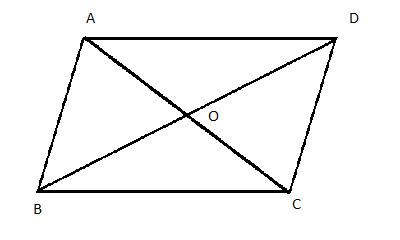Answer
417.9k+ views
Hint: For solving this question first we will see some properties of the parallelogram and then prove the result with the help of ASA (Angle Side Angle) congruence rule.
Complete step by step answer:
Given:
We have a parallelogram as shown in the figure below:

Now, in the above figure in parallelogram ABCD following points should satisfy:
1. AB will be parallel to CD and AD will be parallel to BC.
2. Length of AB = CD and length of AD = BC.
Thus, in a parallelogram opposite sides have equal length and are parallel to each other.
Now, in the above figure:
We can say that, $\angle AOB=\angle DOC$ as they are vertically opposite angles. And $\angle OAB=\angle OCD$ as they are alternate interior angles. Similarly, $\angle OBA=\angle ODC$ as they are alternate interior angles.
Now, in $\Delta AOB$ and $\Delta COD$ . We have:
1. $AB=CD$ ( Opposite sides of the parallelogram are equal).
2. $\angle OAB=\angle OCD$ (Alternate interior angles are equal).
3. $\angle OBA=\angle ODC$ (Alternate interior angles are equal).
Now, by considering the above 3 points with the help of ASA (Angle Side Angle) congruence rule we conclude that: $\Delta AOB\cong \Delta COD$ . As corresponding sides of congruent triangles are equal in length. Then,
$\begin{align}
& AO=CO..........\left( 1 \right) \\
& BO=DO...........\left( 2 \right) \\
\end{align}$
Now, as AC and BD are the diagonals of parallelogram ABCD. Using equation (1) and equation (2). Then,
$\begin{align}
& AO+CO=AC \\
& \Rightarrow 2AO=AC \\
& \Rightarrow AO=CO=\dfrac{AC}{2} \\
& BO+DO=DB \\
& \Rightarrow 2BO=DB \\
& \Rightarrow BO=DO=\dfrac{DB}{2} \\
\end{align}$
Now, from the above results, we conclude that O is the midpoint of AC and BD. So, we can say that AC and BD bisects each other at O.
Thus, diagonals of a parallelogram bisect each other.
Hence, proved.
Note: Here, the student must take care of the geometrical properties of the parallelogram. Moreover, be careful in writing the name of congruent triangles. For example in this question we cannot write that $\Delta ABO\cong \Delta DCO$ , the correct way is $\Delta ABO\cong \Delta CDO$ .
Complete step by step answer:
Given:
We have a parallelogram as shown in the figure below:

Now, in the above figure in parallelogram ABCD following points should satisfy:
1. AB will be parallel to CD and AD will be parallel to BC.
2. Length of AB = CD and length of AD = BC.
Thus, in a parallelogram opposite sides have equal length and are parallel to each other.
Now, in the above figure:
We can say that, $\angle AOB=\angle DOC$ as they are vertically opposite angles. And $\angle OAB=\angle OCD$ as they are alternate interior angles. Similarly, $\angle OBA=\angle ODC$ as they are alternate interior angles.
Now, in $\Delta AOB$ and $\Delta COD$ . We have:
1. $AB=CD$ ( Opposite sides of the parallelogram are equal).
2. $\angle OAB=\angle OCD$ (Alternate interior angles are equal).
3. $\angle OBA=\angle ODC$ (Alternate interior angles are equal).
Now, by considering the above 3 points with the help of ASA (Angle Side Angle) congruence rule we conclude that: $\Delta AOB\cong \Delta COD$ . As corresponding sides of congruent triangles are equal in length. Then,
$\begin{align}
& AO=CO..........\left( 1 \right) \\
& BO=DO...........\left( 2 \right) \\
\end{align}$
Now, as AC and BD are the diagonals of parallelogram ABCD. Using equation (1) and equation (2). Then,
$\begin{align}
& AO+CO=AC \\
& \Rightarrow 2AO=AC \\
& \Rightarrow AO=CO=\dfrac{AC}{2} \\
& BO+DO=DB \\
& \Rightarrow 2BO=DB \\
& \Rightarrow BO=DO=\dfrac{DB}{2} \\
\end{align}$
Now, from the above results, we conclude that O is the midpoint of AC and BD. So, we can say that AC and BD bisects each other at O.
Thus, diagonals of a parallelogram bisect each other.
Hence, proved.
Note: Here, the student must take care of the geometrical properties of the parallelogram. Moreover, be careful in writing the name of congruent triangles. For example in this question we cannot write that $\Delta ABO\cong \Delta DCO$ , the correct way is $\Delta ABO\cong \Delta CDO$ .
Recently Updated Pages
Three beakers labelled as A B and C each containing 25 mL of water were taken A small amount of NaOH anhydrous CuSO4 and NaCl were added to the beakers A B and C respectively It was observed that there was an increase in the temperature of the solutions contained in beakers A and B whereas in case of beaker C the temperature of the solution falls Which one of the following statements isarecorrect i In beakers A and B exothermic process has occurred ii In beakers A and B endothermic process has occurred iii In beaker C exothermic process has occurred iv In beaker C endothermic process has occurred

The branch of science which deals with nature and natural class 10 physics CBSE

The Equation xxx + 2 is Satisfied when x is Equal to Class 10 Maths

Define absolute refractive index of a medium

Find out what do the algal bloom and redtides sign class 10 biology CBSE

Prove that the function fleft x right xn is continuous class 12 maths CBSE

Trending doubts
State the differences between manure and fertilize class 8 biology CBSE

Why are xylem and phloem called complex tissues aBoth class 11 biology CBSE

Difference between Prokaryotic cell and Eukaryotic class 11 biology CBSE

Difference Between Plant Cell and Animal Cell

What would happen if plasma membrane ruptures or breaks class 11 biology CBSE

Give 10 examples for herbs , shrubs , climbers , creepers

What precautions do you take while observing the nucleus class 11 biology CBSE

What would happen to the life of a cell if there was class 11 biology CBSE

Change the following sentences into negative and interrogative class 10 english CBSE



